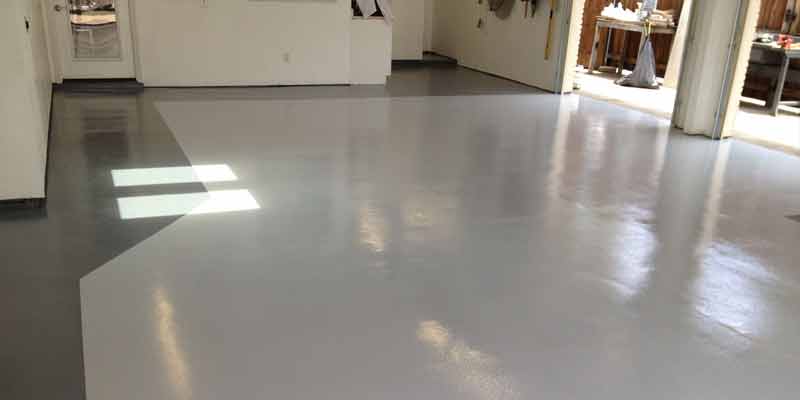One of the most common misconceptions of epoxy flooring is that it is only available in one thickness. This couldn’t be further from the truth! Epoxy flooring is available in a variety of thicknesses, each with its own set of benefits and drawbacks. So, how do you know which epoxy flooring thickness is right for your needs? This article will break down the different epoxy flooring thickness levels and help you decide which is best for your space.
Table of Contents
What is an Epoxy Coating?
An epoxy coating is a resin-based coating that is typically used to protect concrete floors from wear and tear. Epoxy coatings are available in various colors and can be mixed to create custom designs. Epoxy coatings are typically applied in two or more coats, with each coat allowed to dry before the next is applied.
Where is Epoxy Usually Installed?
Epoxy is most commonly installed in commercial and industrial settings where there is a lot of foot traffic or heavy machinery. Epoxy flooring can also be used in residential settings, such as garages or basement floors.
What are the Different Thicknesses of Epoxy Flooring?
Epoxy flooring is available in three different thicknesses: thin-mil, medium-mil, and thick-mil.
Thin-Mil Epoxy Flooring: Thin-mil epoxy flooring is typically between 10 and 20 mils (thousandths of an inch) thick. This type of epoxy is best suited for light to moderate traffic areas. Thin-mil epoxy coatings are typically less expensive than their thicker counterparts and can be applied in a shorter amount of time.
Medium-Mil Epoxy Flooring: Medium-mil epoxy flooring is typically between 25 and 50 mils thick. This type of epoxy is best suited for areas that experience moderate to heavy traffic. Medium-mil epoxy coatings are more durable than thin-mil coatings and can resist impact and abrasion better.
Thick-Mil Epoxy Flooring: Thick-mil epoxy flooring is typically greater than 50 mils thick. This type of epoxy is best suited for areas that experience heavy traffic, such as warehouses or factories. Thick-mil epoxy coatings are the most durable type of epoxy flooring and can resist the heaviest of traffic.
How to Choose the Right Epoxy Flooring Thickness
Now that you know the different thicknesses of epoxy flooring, how do you choose the right one for your needs? There are a few factors to consider when selecting an epoxy flooring thickness, such as:
The amount of traffic the floor will experience: The level of traffic your floor experiences will play a big role in determining which epoxy flooring thickness is right for you. A thin-mil epoxy coating should suffice if your floor sees little to no traffic. If your floor experiences moderate to heavy traffic, however, you’ll want to opt for a medium- or thick-mil coating.
The type of environment the floor will be in: Your floor’s environment can also affect the type of epoxy coating you’ll need. If your floor is exposed to harsh chemicals or UV light, you’ll want to choose a thicker epoxy coating.
The amount of time and money you’re willing to invest: Thicker epoxy coatings are typically more expensive and take longer to apply than thinner coatings. If you’re working with a tight budget or timeline, a thin-mil epoxy coating may be the best option for you.
No matter what thickness of epoxy flooring you choose, be sure to partner with an experienced installer who can ensure a high-quality, long-lasting finish.
Different Types of Coating Additives
Now that you know the different epoxy flooring thickness levels, you may be wondering what type of coating additives are available. Coating additives can be mixed into your epoxy coating to add color, texture, or extra protection. Some of the most popular types of coating additives include:
Color Pigment: Color pigments can be mixed into your epoxy coating to create a custom color. This is a great way to add some personality to your space or match your company’s branding.
Anti-Slip Additive: Anti-slip additives can be mixed into your epoxy coating to create a slip-resistant surface. This is ideal for areas that may get wet, such as pool decks or kitchen floors.
UV Resistant Additive: UV-resistant additives can be mixed into your epoxy coating to create a finish that is less likely to fade in direct sunlight. This is a great option for outdoor spaces or rooms with large windows.
When choosing an epoxy flooring thickness, be sure to consider the type of environment your floor will be in and the amount of traffic it will experience. You should also partner with an experienced installer to ensure a high-quality, long-lasting finish.
Now that you know the different thicknesses of epoxy flooring, you can work on creating the perfect floor for your needs. Just remember to take into account the environment, traffic, and budget when selecting an epoxy coating thickness. And don’t forget to partner with an experienced installer for the best results!

